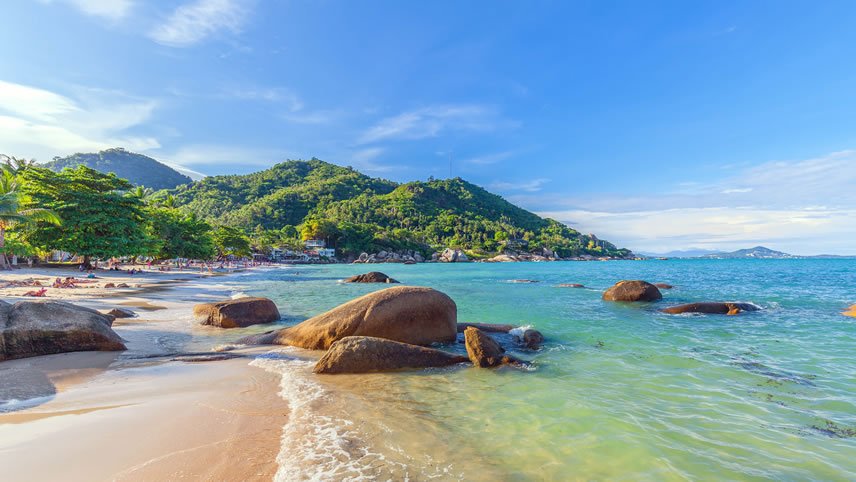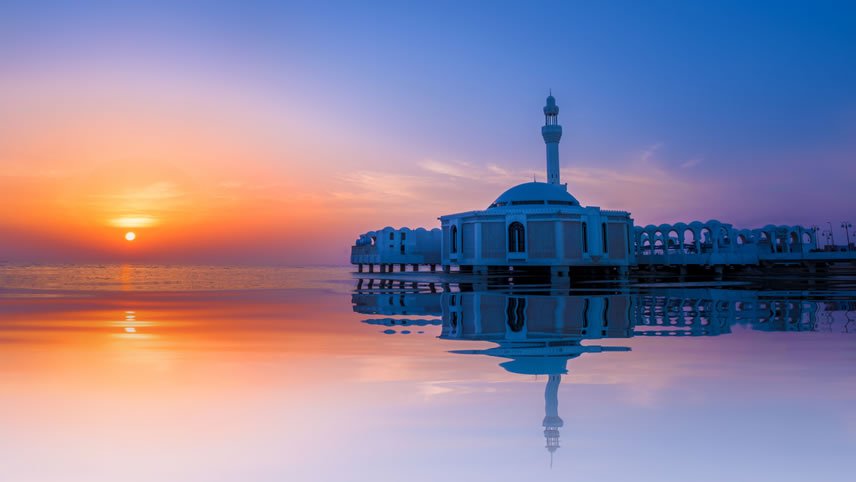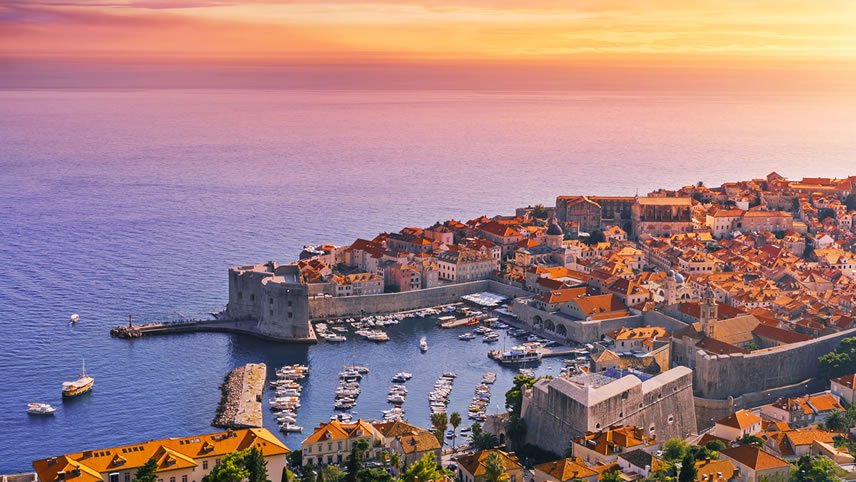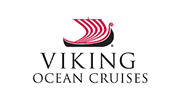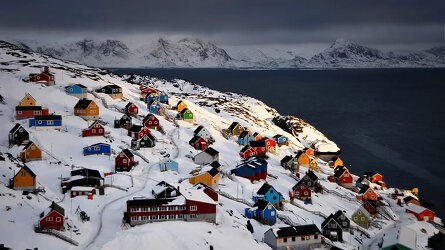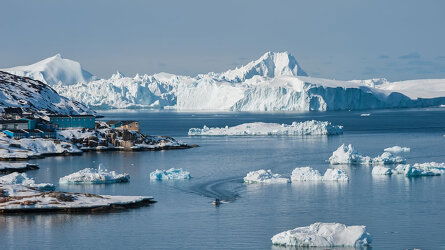Overview
Itinerary
Embark your ship and settle into your stateroom. Sydney was founded as a penal colony in 1788 and is celebrated for its magnificent natural harbor. It has grown into the major cultural center of Australia, beloved for its all-embracing, free-spirited nature. The cultural jewel in its crown is the iconic Sydney Opera House, a UNESCO World Heritage Site nestled harborside like a gleaming white bird taking wing. Adjacent, the Royal Botanic Garden displays one of the world's most important horticultural collections across its 70 acres of flora-lined pathways.
Newcastle boasts some of the most picturesque coastal vistas in Australia. The city was built on coal export and remains a major exporter. But locals care more about soaking up the spectacular outdoors. High cliffs, well-kept green parks and long stretches of beach grace these shores. And the people of Newcastle know how to keep connected to their breathtaking surroundings: They have built ocean baths along the shore that collect sea water during high tide. Nearby, in one of the country's first wine regions, the vintners of Hunter Valley bottle some of the coast's favorites.
Trace the scenic Australian coastline, indigenous people inhabited the continent for 60,000 years prior to European discovery. As you sail, take advantage of the array of delicious cuisine offered on board. You may visit Mamsen's, our casual gourmet deli, any time from early morning to late at night for a taste of traditional Norwegian fare. Or, dine at Manfredi's and savor an authentic Italian meal, with options ranging from Milanese risotto to Tuscan inspired classics.
The capital of Queensland, Brisbane is situated on its namesake river and spreads over picturesque hills rising from Moreton Bay. One of the oldest cities in Australia, its first European settlers were the secondary offenders from the Sydney penal colony. In addition to its riverside skyscrapers, the city is host to some decidedly less dramatic architecture: the quaint Queenslander homes characterized by their terraces and raised living spaces. Art galleries, museums and beloved musical venues also make the city one of Australia's most vibrant and active cultural centers.
Follow the route of English explorer James Cook, who famously laid eyes on Australia's “Sunshine Coast” from the deck of the HMS Endeavour. Enjoy the amenities of your ship as you sail. Perhaps take a breath of fresh air on a brisk walk around the Promenade or begin your day with a workout in the well-equipped Fitness Center.
The Whitsunday archipelago emerges from the Coral Sea amid the Great Barrier Reef. The seafaring Ngaro people called this paradise home until 1870 and hunted these waters in bark canoes. Nature's brushstrokes are astonishing here: pure-white sands meet cerulean waters, swirling together at sandbars to merge into a palette of turquoise, cream and emerald-green hills. Glassy, invigorating and impossibly blue, the waters provide the ideal oasis for relaxing and idling away a few hours on the beach.
Townsville is the unofficial capital of North Queensland and a favorite cultural center. The city's location on the banks of the Ross River and along the shores of Cleveland Bay hints at the local love of outdoor life. Riverway, a path-lined green park that traces the Ross, leads walkers and joggers past scenic views and the city's original wharves and ports. Nearby, The Strand, a tranquil walkway, follows the long tropical beach. And no matter which corner of Townsville you are exploring, the red sandstone monolith of Castle Hill is always in view.
Queensland's seaside resort town, Cairns is the gateway to a rich array of natural beauty onshore and off. Catamarans take marine lovers to the Great Barrier Reef; stretching for 1,400 miles, it is the largest continuous coral reef system on Earth. Inland, the wet tropics have given rise to Daintree and Kuranda National Parks, vast rainforest systems of extraordinary biodiversity and a profusion of birdlife. For all its appeal to outdoor enthusiasts, Cairns' thriving culture is a pleasure to absorb from the outdoor cafés or along the scenic waterfront promenade.
Traverse the mineral-rich waters of the Coral Sea, where the world-renowned Great Barrier Reef welcomes divers to explore its spectacular marine life. Admire the views as you sail today and enjoy an al fresco dining experience. The Aquavit Terrace serves a range of International fare and casual dining favorites, as well as a range of superb cocktails inspired by our destinations.
Thursday Island was once home to a thriving pearl fishing industry. From the late 19th century, divers came from Japan, Malaysia and India to harvest these precious stones. The diving has declined, but traces of Asia's diverse influences remain. The island's Green Hill Fort was built during the 1890s with growing concerns of a potential Russian invasion. The fort was shut down just 30 years later and reactivated during World War II as a wireless station. Many islanders, still to this day, abide by a no-footwear policy out of respect for the spirits of their ancestors.
Trace the route of early civilizations as you sail the Arafura Sea. During the Ice Age, entire populations were once able to walk between continents, exchanging languages and customs. Linger on the Sun Deck of your veranda for vistas of azure and turquoise as you sail through some of the world's most beautiful waters. Perhaps you will take a dip in the Infinity Pool or stroll the Promenade Deck.
Darwin is the cultural hub of the continent's northernmost region. The laid-back city got its name after the HMS Beagle sailed into the harbor during a surveying expedition in 1839. The famed naturalist Charles Darwin was so esteemed that its captain named this newest discovery for him. Today, it is the largest city in the thinly populated Northern Territory state. It boasts a rich and lively arts and culture scene, much of it centered on the Museum and Art Gallery of the Northern Territory. Its collection of art and artifacts reflects the region and its indigenous people.
Darwin may be far removed from Australia's other provincial capitals, but it is proudly cosmopolitan. Its varied museums highlight the rich history and abundant marine life. The Royal Flying Doctor Service museum chronicles the organization's part in World War II and illuminates its current role in the bush. On the waterfront, the Indo-Pacific Marine Exhibition recreates various underwater ecosystems, each one self-sustaining with no feeding or filtration, providing unique insight into fascinating aquatic worlds.
Follow in the footsteps of Indonesia's indigenous people and sail the Timor Sea. This stretch of water shares its name with the independent state of East Timor, which lies to its north. Spend a relaxing day at sea to unwind and admire the vistas from your stateroom veranda.
Komodo is one of the world's most unique and prehistoric-feeling national parks with a magnificent menagerie of wildlife. Its most famous denizen is the legendary Komodo dragon, the largest lizard in the world. These breathtaking creatures can grow up to ten feet long and typically weigh about 150 pounds. Gentler-looking animals also roam, including the island's graceful Timor deer, beautiful wild horses and stout little boars. Resident giant fruit bats, also known as flying foxes, are a sight to behold with their jet-black capes.
Lombok exudes a relaxed atmosphere in a tropical setting. Wood carvers, potters and other artisans keep artistic traditions alive, finding endless inspiration in the lush forests, the soothing sands and the soaring peak of Mt. Rinjani, the nation's second-tallest volcano. The crafts of the island are steeped in the artistry of the indigenous Sasak people. The island is also home to pearl divers who pluck these treasures from the sea and offer them for sale. On the western shore, Senggigi is home to the island's best beach, stretching several miles along a lush, green coast.
With a thriving arts scene, lush beauty and magnificent seaside vistas, Bali has long beckoned travelers in search of ultimate beauty. The island's rich Hindu culture has forever held that gods live in all things natural—from mountains to streams to pebbles on the beach—lending the island a peaceful air. Denpasar is the island's thriving capital. Founded as a market town, it still bustles with colorful stalls and vast emporiums selling bright sarongs and intricately patterned batik.
With its distinct flavors and traditions, Bali's food culture stands apart from that of the rest of Indonesia. Indigenous ingredients, recipes and techniques blend with influences from the island's Chinese and Indian heritages to create dishes found nowhere else. For many, a daily ritual may involve shopping for ginger, turmeric and kaffir lime in spice markets or for fruits, vegetables and meats in a pasar pagi. Traditional warungs, tiny family-owned food stands, often specialize in a particular dish, such as babi guling (suckling pig) or bebek betutu (crispy duck).
Surabaya played a central role in the Indonesian War of Independence. The memorials to that struggle stand as soaring testaments to the will and courage of the Javanese. Today, Surabaya is a diverse patchwork of vibrant cultures. Mosques stand proudly in the Arab district and elegant churches adorn the European quarter. But perhaps the most authentic way to fully experience Java's varied cultural influences is by tasting them. A stroll through the Pasar Pabean traditional market reveals fresh fish, vegetables, spices, incense and countless other specialties.
Java is Indonesia's repository of history and island culture. The bustling port of Semarang was founded by the Dutch and hints of the island's colonial past dot the cityscape. Outside the city, Borobudur, the largest Buddhist monument in the world, strikes a dramatic pose against a backdrop of four volcanoes. A popular place of pilgrimage and a UNESCO World Heritage Site, the massive pyramidal temple towers to a great height. The devout walk up a clockwise path to the pinnacle, passing 2,672 reliefs and 504 Buddha statues along the way.
Jakarta is a melting pot of cultures and a bustling capital. The city has been important to trade since the 4th century; it was founded as Sunda Kelapa, a significant trading port for the Sunda Kingdom, the Hindu realm that once occupied this area. The Dutch arrived in 1619 to establish the Dutch East Indies, renaming the city Batavia and proclaiming it their capital. Nutmeg, cloves, cinnamon and more were exported from here. During the Japanese occupation of World War II, the Dutch were expelled and the city took its current name, which it retained after independence.
Jakarta is an enormous mélange of cultures imported from Indonesia's 6,000 inhabited islands. Whether strolling the capital's outdoor markets or dining at a high-end restaurant, the city's menus reveal a cornucopia of cuisines that reflect the varied traditions of today's Jakartans. The local Betawi food is the culmination of centuries of Malay, Chinese, Javanese and other influences. Gado-gado, salad in peanut sauce, is one popular dish. Countless variations of skewered meats, fried rice and dumplings are also on offer.
Sail one of the world's most successful commercial trade routes in history. The countless crates of spices carried over the Java Sea reportedly contributed to the famed Dutch Golden Age. As you sail today, relax in the Explorers' Lounge, inspired by epic journeys of discovery. Marvel at the views through the two-story panoramic windows as you share a cocktail with friends, or settle down to read a book.
Singapore is the world's only island city-state. Established in 1819 for the East India Company by Sir Stamford Raffles, after whom the famed hotel is named, it grew from a secluded backwater into a shabby port city before transforming itself into a sophisticated metropolis. The technology and economy are highly advanced here, yet the islands host plentiful green parks with tree-lined footpaths and the stunning National Orchid Garden. For a panoramic view of it all, the observation deck of the Marina Bay Sands towers offers the perfect solution.
The capital of Malaysia, Kuala Lumpur was built by Chinese tin prospectors in the mid-1800s. Since then, the city of KL, as the locals call it, has grown into a stunning mix of colonial, Moorish, Tudor, neo-Gothic and Grecian-Spanish architecture. The two-story shophouses of Old Market Square, with storefronts below and residences above, reveal the lives of merchants. The magnificent Petronas Towers are the centerpiece of this fascinating city; the side-by-side twin spires resemble a pair of rockets, connected by a two-story sky bridge that spans the 41st and 42nd floors.
This narrow passage between Malaysia and the Indonesian island of Sumatra was a major route for early traders shipping glassware, precious stones, camphor, ivory and sandalwood. Today, it is one of the busiest shipping channels in the world, linking the Indian and Pacific Oceans. Along this historic waterway, the lush shores of Sumatra grace the horizon to the south, stretching out to lowlands, mangroves and swamps. The more urban skylines of Malaysia—George Town and Kuala Lumpur among them—shimmer in the distance to the north.
The Gulf of Thailand, the massive sea basin bordered by Vietnam, Cambodia, Thailand and Malaysia, is still known as the Gulf of Siam to the Malay and Khmer people. Long stretches of sandy beach, low-lying emerald hills and soaring mountains surround this oval-shaped gulf. The lush hills of Botum Sakor National Park unfold north of Sihanoukville, Cambodia. Along Thailand's shores, several beach-ringed islands point the way to Laem Chabang port.
Often called the “City of Angels,” Bangkok is Thailand's largest and most populous city. A sprawling and heady mix of modern skyscrapers, floating markets and longtail boats skimming the Chao Phraya River, the scintillating capital of old Siam engages all the senses. Yet it all seems devoutly grounded by the presence of its revered gilded wats, or temples. Wat Arun, in particular, can be seen from all corners of the city. This majestic riverside “Temple of Dawn” catches the first light of each day like a pearl, casting a soft glow on one of Asia's most remarkable cities.
Historic Siam of old, Bangkok is beautifully set on the Chao Phraya River. Thai culture is rich and engaging in this bustling center, and its origins are reflected through centuries-old Buddhist wats, or temples. The towering Wat Arun, named for the god of the rising sun, stands dramatically on the river's banks. The revered temples and elegant buildings within the walls of the renowned Grand Palace date to the late 1700s. A gilded array of golden pagodas and stupas (shrines), it has been the royal family's residence for more than 150 years.
Amid the bustle of cosmopolitan Bangkok, numerous temples pay tribute to the Buddha and his role in Thailand's spiritual life. The most prominent is Wat Arun, its soaring spire represents Mount Meru, mythology's home of the Hindu gods. At the 17th-century Wat Pho, Thailand's oldest and largest temple, a gold-leafed Buddha lies in repose. While the most venerated Buddha in the nation resides on the Grand Palace grounds in Wat Phra Kaew, the Temple of the Emerald Buddha. The 26-inch-tall figure carved from semiprecious jade draws pilgrims from all over the world.
Koh Samui is Thailand's second-largest island after Phuket and a paradise of swaying palms and scenic beaches. Sun-loving beachcombers from Thailand and beyond come to the island to wade, swim and lounge in the lapping tides. Until the early 1970s, this self-sufficient community had no roadways; crossing the island required a full-day trek across nine miles of mountainous jungle. Today, Koh Samui retains the slower pace of simpler times. The cherished traditions of old Siamese fishing villages, too, are preserved as tiny boats gently bob on turquoise waters.
Surrounded by palm-lined shores, idyllic resort towns and bustling port cites, the Gulf of Thailand provides an enriching glimpse of seaside locales in Southeast Asia. Home to a large diversity of marine life, the waters themselves also draw admirers of some of the world's most elusive sea creatures. Whale watching ships set off from shore hoping to spot Eden's whales and rare dwarf fin whales, sometimes encountering the Chinese white dolphin, Irrawaddy dolphin, manatee-like dugongs and the endangered hawksbill turtle.
Singapore transformed from a sparse island to the economic giant of Southeast Asia. Malays, Indonesians, Indians, Sri Lankans and Chinese have all contributed to the city's rise as one of the world's most technologically advanced cities. Buddhist, Hindu and Taoist temples rub elbows with Muslim mosques and Christian churches, alongside street signs in English, Chinese, Tamil and Malay. Singaporean cuisine, too, has been shaped by the many cultures that have converged here; there is no better place to sample local fares than at one of the city's many open air food courts.
While Kuala Lumpa is renowned for its modern face, the Malaysian capital is also home to a wealth of historic sites and natural treasures. The Batu Caves is a sacred Tamil shrine with gleaming religious statues and has been used as a shelter and place of worship for millennia. Visitors are greeted here by the resident macaque monkeys. The center of the city also features a tropical rainforest, offering a tranquil haven for locals and visitors to explore the diverse flora and fauna. The city, however, comes alive at night, with its bustling markets serving street food.
Capital of the Malaysian island of Penang, George Town has long been a crossroad. Today, it is a glorious celebration of culture, one of Asia's most colorful corners. Malays, Indians and Chinese all share a past here, as a ride around town via a pedaled trishaw will show. George Town's unique cityscape features shops from colonial days, Buddhist and Taoist temples, and kongsi, brightly painted clanhouses that traditionally open their doors to all who share a surname. The town's rich literary past includes residents such as Rudyard Kipling, Somerset Maugham and Noël Coward.
This narrow passage between Malaysia and the Indonesian island of Sumatra was a major route for early traders shipping glassware, precious stones, camphor, ivory and sandalwood. Today, it is one of the busiest shipping channels in the world, linking the Indian and Pacific Oceans. Along this historic waterway, the lush shores of Sumatra grace the horizon to the south, stretching out to lowlands, mangroves and swamps. The more urban skylines of Malaysia—George Town and Kuala Lumpur among them—shimmer in the distance to the north.
The history-rich waters of the Bay of Bengal are considered sacred by many Hindus. In ancient Hindu lore, the bay is called Mahodadhi, meaning 'great water receptacle.' Still today, the devout perform a daily aarti, a religious ritual in which they place fire offerings into the surf and let the tides carry them away. During the early 1600s, Britain's East India Company sailed along the coast, settled throughout India and established a trading body; soon after, half of the world's maritime commerce of goods such as cotton, silk and tea were traded exclusively through them.
Brimming with old-world charm, Colombo is Sri Lanka's cultural epicenter. With its large harbor and strategic seaside location, Colombo quickly earned favor among ancient traders. The island was first colonized by the Portuguese, followed by the Dutch, then the English, who ruled until the country gained independence in 1948. Still today, evidence of all three nations is clear in the cuisine, language and architecture. Within the city's 19th-century fortress stands the neobaroque Old Parliament Building, and the city's streets carry the names of former British governors.
Sri Lanka's rich culture, colonial history and stunning setting merge along the mile-long Galle Face Green, nestled between the ocean and the business district. On this welcoming lawn kissed by sea breezes, young men play cricket, couples stroll and children fly kites. Food vendors may tempt passersby with isso wade—deep-fried shrimp cakes—or other treats. The prestigious Galle Face Hotel, built by the British in 1864, serves refreshing gin and tonics and offers a complete tea service. Its veranda is the perfect spot to watch the sun set over the Indian Ocean.
Sail the azure waters between the island nations of Sri Lanka and the Maldives at the tip of India's southern point. The Laccadive Sea has been a thriving region for pearl fishing for thousands of years. As you sail today, savor a range of international cuisine on board. Choose from a variety of international flavors at the World Café, enjoy al fresco dining on the Aquavit Terrace, or regional specialties in The Restaurant.
Goa was the cultural center of Portuguese India for 450 years. This was the first region in India colonized, and the last to get its freedom. Nowhere in India is the colonial influence so prominent. About a third of Goans are Catholic and the colonial styles of the Old Town have earned it a place as a UNESCO World Heritage Site. Among its magnificent cathedrals and monasteries, the Sé Cathedral is one of the largest churches in Asia. The Basilica of Bom Jesus, a fine example of baroque architecture, holds the remains of St. Francis Xavier, the city's patron saint.
Mumbai is spread over seven islands and is a major cultural capital of India. Bombay, as it was known until 1995, still enjoys its magnificent seaside setting and is home to some of India's most beloved landmarks. Perhaps none is as glamorous as the Taj Mahal Palace hotel. Overlooking the Arabian Sea, it has hosted celebrities and presidents. Adjacent, the impressive Gateway of India was built to salute the arrival of King George V and Queen Mary in 1911. Mumbai also hosted the headquarters of Mahatma Gandhi.
Mumbai encompasses every element of humanity and is a striking blend of cultures and traditions. Millionaires and laborers rub shoulders on bustling streets. Bollywood film directors create big-budget films among a culture of fashionistas and financiers. The city's streets reflect every subculture, religion and cuisine of India, as people migrated here from all over the country. And the city's festivals honor both Western and Indian traditions, from Good Friday to the Kala Ghoda Arts Festival, a celebration of local music, dance, theater and film.
The skyline of Mumbai is an eclectic combination of architectural styles, from Gothic to Victorian and from art deco to contemporary expressions. Several of these structures are listed as UNESCO World Heritage Sites, including the historic Chhatrapati Shivaji Maharaj Terminus, a 19th-century Victorian neo-Gothic train station built to mark the 50th anniversary of Queen Victoria's reign. The city is also home to a collection of 94 UNESCO-protected Victorian-era and art deco buildings set around the spacious greenspace of Oval Maidan.
Cross the Arabian Sea, originally called the Erythraean Sea, after King Erythras of Greek mythology. Its modern-day moniker derives from the Arab sailors who dominated trade on its waters from the 9th century onward. Renew your body, mind and spirit in our Scandinavian-inspired Spa, a Nordic sanctuary of holistic wellness, today while at sea. Whether you unwind in the Sauna, refresh in the Snow Grotto or take a dip in the Thermal Pool, you will feel recharged and revitalized.
Muscat enjoys a stunning setting between the Arabian Sea and the rocky Western Al Hajar Mountains. A rich and romantic canvas of low whitewashed buildings watched over by traditional dhow fishing boats bobbing in the harbor, the city is also a trove of royal and Islamic treasures. The Sultan Qaboos Grand Mosque was named for the beloved leader who has bolstered the country's economy; a dazzling expanse of white marble, intricate wooden panels and magnificent stained glass windows. Hints of the country's past as a Portuguese outpost can be found in Old Muscat.
Sail the Arabian Sea, an important marine trade route since Antiquity. During the Age of Sail, all manner of spices, metals and precious stones were carried back and forth across these waters by industrious traders. As you sail today, attend an informative lecture or watch a film in our state-of-the-art theater. A range of insightful TED Talks and desination-inspired seminars are offered daily.
The Omani city of Salālah is situated on the southeastern edge of the Arabian peninsula and was a major port on the 13th-century frankincense route. This fascinating cultural history was supported by several sites around the city, such as ancient towns and caravan oases, some of which are UNESCO World Heritage Sites today. Salālah is often called the “Garden City” for the greenery and coconut trees that line its streets and boulevards. One of its most impressive sites is the Sultan Qaboos Grand Mosque, with its richly adorned Islamic architecture.
Follow the centuries-old trade route linking the Red Sea to the Arabian Sea. This historic waterway was named for the former British Crown Colony city of Aden, an adjacent port in today's Yemen. Meet fellow guests and listen to the soothing sounds of classical music in the Living Room, an ideal setting for relaxation. Enjoy a cup of coffee or sip on a refreshing cocktail.
Follow in the wake of early explorers who sailed the waters of the Red Sea as long ago as 2500 BC. History and legend are rich in this narrow stretch of sea between Asia and Africa. As you sail, explore our well-curated Library, tucked in a private alcove of the Living Room, and select from a broad range of titles. Read a book by the Main Pool, a calming oasis in any weather with its retractable roof, allowing for year-round swimming.
Saudi Arabia's second-largest city, Jeddah has played a dual role throughout its history. Located on the eastern shores of the Red Sea, it was a major port for Indian Ocean trade routes starting in the seventh century. It also became a historically important gateway for Muslim pilgrims arriving by sea on their journey to the holy cities of Mecca and Medina—a role that continues to this day. A modern multicultural city, Jeddah's heritage can still be experienced in the distinctive architecture and bustling souks of its historic Old Town, a UNESCO World Heritage Site.
Trace the coastlines of Africa and Saudi Arabia as you sail the Red Sea, one of the world's most legendary seaways. Moses is said to have parted its waters and Egyptian Queen Hatshepsut led trade missions here on ancient vessels. As you sail, take advantage of the array of delicious cuisine offered on board. You may visit Mamsen's, our casual gourmet deli, any time from early morning to late at night for a taste of traditional Norwegian fare. Or, dine at Manfredi's and savor an authentic Italian meal, with options ranging from Milanese risotto to Tuscan inspired classics.
Jordan's only coastal city, Aqaba is set amid coffee-colored desert hills. With its central location between Africa and Asia, it has played a significant role in the region's trade for thousands of years. Today, its prosperity rests in its position as the sole port of the nation and in its pristine dive sites. The city's history, too, draws inquisitive travelers. In 1917, T.E. Lawrence (known as Lawrence of Arabia) led troops here in the Battle of Aqaba. The white-robed English ally helped the Arabs run the Turks from the city's fortress during a camel charge.
Luxor is set on the east bank of the Nile River and once served as the capital of Egypt's New Kingdom. Today, it is a UNESCO World Heritage Site lined with beautiful colonial hotels and some of the world's most ancient and significant ruins. Many consider this city, watched over by graceful single-sailed feluccas plying the Nile, one of the world's great open air museums. The sprawling Temples of Luxor and Karnak on the east bank are linked by the ancient Avenue of the Sphinxes. On the west bank, in the Valley of the Kings, lie the tombs of Egypt's great pharaohs.
Egypt's seaside resort of Sharm el-Sheikh is often called the “City of Peace” for the number of international peace conferences held here. Its location, where major bodies of water meet, has transformed from a modest fishing village into a major port. However, “Sharm,” as it is known by locals, is renowned for its unrivaled scuba diving among vibrant coral, dramatic rock formations and reef walls. The surrounding desert, too, though less colorful, exudes its own stark beauty. A Jeep safari is the ideal way to explore beyond the scenic jagged mountains that hug the town.
An engineering marvel, the Suez Canal was completed in 1869. The sea-level, single-lane waterway has no locks, and only two lakes allow north- and southbound ships to pass each other: Ballah Bypass and Great Bitter Lake. Along this historic waterway, stark desert sands stretch into Egypt and an occasional giant mound of sand appears on its banks, dug from the canal. Small patches of swaying palms are fed by canal waters. Nearby lies the town of Ismailia, known as the “City of Beauty and Enchantment,” which was built to serve the canal's construction and maintenance.
It has been said of Egypt's exhilarating capital, “He who has not seen Cairo has not seen the world.” Certainly, the heart of the nation beats with an unbridled passion in this city made prosperous over millennia as a stopover for Sahara caravans on trade routes to Byzantium. Amid the stimulating strum, the insistent beauty of everyday life reigns here, with the serene Nile sliding through like an entrancing serpent. Cairo's very age mesmerizes; its monuments have stood here for more than 5,000 years.
Haifa is one of Israel's most important and beautiful cities, built on the slopes of Mount Carmel and overlooking the Mediterranean Sea. Pilgrims of the Bahá'í faith flock here to visit the Hanging Gardens of Haifa, a series of breathtaking terraces on the hillside. Mount Carmel also holds significance to Jewish, Christian and Islamic faiths. Most notably, this was the spot of Elijah's sacrifice by fire by which he miraculously ended a drought. Nearby, the ancient city of Acre, one of the oldest continuously inhabited cities in the world, is a UNESCO World Heritage Site.
High above Haifa, brilliant blooms spill down the side of Mount Carmel, a site significant in Judaism, Christianity and Islam. This place is also meaningful to those of the Bahá'í faith, who travel here from afar to see the Hanging Gardens of Haifa. The beautifully landscaped swath of flowers and topiary, arranged around wide, elegant mountainside stairways and plazas, creates stunning geometric designs. From Mount Carmel's tabletop summit, visitors take in the breathtaking terraced gardens against the expansive backdrop of the city below and the Mediterranean beyond.
Sail along one of the world's most beautiful coastlines, known for its azure waters and picturesque islands. Enjoy the amenities of your ship as you sail. Perhaps take a breath of fresh air on a brisk walk around the Promenade or begin your day with a workout in the well-equipped Fitness Center.
Athens has been called the “birthplace of democracy.” Its legacy looms large from atop Acropolis Hill, the pinnacle of ancient Greece. This open air museum is an astonishing repository of once-mighty structures. From its colonnaded Parthenon—more than 2,600 years ago—revered Greek philosophers like Plato and Aristotle formulated new ideas of government and debated its role in civic life to captivated audiences. Remnants of spiritual life are also here in the several temples to Athena and Zeus.
Katakolon is huddled around a pretty little harbor dotted with colorful fishing boats. Nearby, the fertile valleys of the western Peloponnese are a bounty of olive groves, vineyards and orchards, and lead to the legendary city of Olympia. The well-kept ruins here transport visitors back to the days of the earliest athletes who competed for nothing less than the favor of the gods. The remains evoke the glory of the Games, and the Olympia Archaeological Museum features statues that once overlooked the site.
Corfu has a rich history shaped by conquerors and by royalty seeking tranquility. Corfu's Old Town and Fortress—fashioned by the once powerful Venetian Republic—comprise a UNESCO World Heritage Site. Its narrow warrens lead to one of Europe's largest public squares and a lovely promenade once exclusively reserved for the local aristocracy. Everywhere, magnificent coastal views unfold and scenic byways lead to history-rich enclaves, from the archaeological site of Paleopolis and the stunning Vlacherna Monastery to a former Greek royal villa.
Kotor is Montenegro's picturesque capital set amid glorious mountains and dramatic scenery. Towering cliffs soar above the narrow Kotor ria—a submerged river canyon often called Europe's southernmost fjord. Kotor is also home to one of the Adriatic's best-preserved medieval Old Towns. The charms of this red-roofed city are endless, from the mismatched towers of its Romanesque cathedral to its narrow streets. Its stunning Venetian walls were built in 1420, remnants from Kotor's nearly 300 years as a province of the Venetian Republic.
Dubrovnik is a historic jewel, with its spectacular Adriatic setting, 12th-century medieval streets and incredibly preserved structures. So stunning is its Old Town, the playwright George Bernard Shaw famously called it “paradise on Earth.” It is all spectacularly surrounded by a towering medieval wall. Inside, the ancient city's Stradun is lined with authentic stone houses. The peaceful 14th-century Franciscan Monastery and Apothecary, housing the world's oldest working pharmacy and fine collection of Renaissance paintings, provide insight into the ages.
Built around the Roman Palace of Emperor Diocletian, Split is one of Croatia's oldest cities. Its promenade commands majestic views over a bay and the Adriatic Sea. Despite evidence of Split's origins in the 6th century BC, the city is traditionally considered over 1,700 years old—counting from the construction of the palace. Its well-preserved remains have been seamlessly assimilated into the modern city. An Ethnographic Museum is found at the palace's heart and shops line the passageways of its ancient basement. Diocletian's ancient mausoleum is now a stunning cathedral.
Fusina is the gateway to Venice, a wondrous patchwork of graceful piazzas, tranquil canals, artful footbridges and Gothic splendor. This impossibly romantic place is made dreamier still by a serene gondola ride. To view its riches up close, walking is best. All things Venetian begin in St. Mark's Square, where its elegant bell tower rings over the rooftops, and the Byzantine-Gothic St. Mark's Basilica seems to preside over all. Beyond St. Mark's and away from the crowds, Venice is a hushed and fascinating city to explore, with medieval echoes marking your every step.
Chioggia is a charming fishing community located at the southern end of the Venetian Lagoon and steeped in age-old seafaring traditions. Its combination of canals, bridges and fishing boats have lent it the nickname 'Little Venice.' Lined with shops, bars and restaurants, the main pedestrian street of Corso del Popolo exudes a lively atmosphere amid the aroma of delicious fresh seafood dishes. Chioggia shares a long history of cultural and economic ties with Venice, dating back to the Middle Ages, and is a scenic journey by water taxi from the capital of the Veneto region.
The Venetian Republic ruled Adriatic waves for a millennium. During the 8th century as the Roman Empire began to decline, many Europeans fled to Venice and its neighboring towns, including Chioggia. Merchants put their skills to use, and the city-state was soon thriving. The Venetian Lagoon's canal banks feature buildings influenced by Byzantine and Islamic architecture, reflecting Venice's powerful trading network. The first vaporetto traversed the Grand Canal in 1881; alongside the gondolas, these iconic Venetian water buses are at the heart of Venice's transport network.
Šibenik is the oldest Croatian city on the Dalmatian Coast. The remarkable architecture of this UNESCO World Heritage Site spans the centuries, having witnessed the rise and fall of empires, from Byzantine to Venetian. In its remarkably preserved Old Town, narrow cobblestone streets lead past medieval houses and churches, all surrounded by four historic fortresses, including the imposing St. Nicholas Fortress. St. James Cathedral, built by several architects in the Gothic and Renaissance styles over a century, is the most important Renaissance structure in Croatia.
Located at the heel of Italy's boot, Bari boasts a sunny, palm-lined promenade, romantic honey-toned balconied houses, welcoming courtyards, and Romanesque and baroque churches. It is pure pleasure to take in the distinct Mediterranean atmosphere of this picturesque port, with colorful fishing boats bobbing on the turquoise harbor. History and culture take center stage at the splendid Norman-Swabian Castle; the Romanesque Basilica of St. Nicholas, named for the city's patron saint; and the Petruzzelli Theater, one of Italy's most important opera houses.
Crotone, according to Ovid, was named by Hercules himself in memory of a friend he had accidentally slain. Today, it is the capital of its eponymous province, a region known for its pristine waters, untouched mountains and vast forests. As the gateway to a landscape bestowed with great natural beauty, Crotone prides itself in its deep historical roots, which can be traced back to the 7th century BC in the city's archaeological museum and the ruins of two redoubtable fortifications, the Castle of St. Charles V and Le Castella, situated on a small peninsula south of the city.
Sicily has been shaped by countless civilizations, from Greek to Byzantine to Roman. When it fell under Spain's purview in the 17th century, it was celebrated as one of Europe's ten great cities. Surrounded by undulating mountains, orange and olive groves and vineyards are plentiful. During World War II, Messina was the destination of the unofficial “Race to Messina” between US General Patton and British Field Marshall Montgomery. In the end, Patton arrived just hours before his British comrade, receiving credit for securing Sicily.
Naples boasts a long history in a stunning seaside setting and is known mostly for its pizza. The city has long been a major center of Italian culture and was the seat of a powerful independent kingdom for 500 years. So great was its sway that it lured the region's finest architects and artists. In the grand Piazza del Plebiscito, the grand and sweeping public square, the San Francesco di Paola Church flaunts a colonnaded facade reminiscent of the Pantheon in Rome, and the Royal Palace overlooks Neapolitans with statues of all the kings of Naples peering out from alcoves.
For centuries, Rome ruled much of Europe, building a vast empire from the power of emperors. More than 2,500 years of history live in the city's streets. Ancient structures recall those heady days when the cheers of 80,000 spectators roared from the Colosseum, citizens mingled in the Forum and senators asked the gods for guidance at the Pantheon. Along with the Vatican and St. Peter's Basilica, this rich pocket of Italy is one of the world's greatest repositories of history and civilization.
Tuscany is known equally as the cradle of the Renaissance and a center of culinary delights and astounding wines. Throughout this emerald-green countryside dotted with cypress trees, endless delights unfold. Among them is Florence, a living museum of the Renaissance. Brunelleschi's famous Duomo dominates the medieval cityscape—an architectural achievement. Another Tuscan treasure, the Square of Miracles, unfolds in Pisa. Here, a trinity of masterpieces—the Leaning Tower, Pisa Cathedral and Baptistery—comprise some of Europe's finest art and architecture.
Tuscany is known for its scenic beauty and exudes a unique, rustic character. Vineyards, olive tree groves, wheat fields and endless expanses of farmland skirt the bases of medieval hill towns as they march across an undulating landscape of gentle hills. Fertile soils produce some of the world's finest wines, including Chianti and Vino Nobile di Montepulciano. More than this, many consider Tuscany the birthplace of the original farm-to-table movement. Simple, honest food graces the Tuscan table, from creamy cheeses to thick Florentine steak grilled over a wood fire.
The chic city of Monte Carlo in the petite kingdom of Monaco boasts some of the world's most exclusive shopping and a beautiful old port. A fairy-tale aura has settled on this glittering city of the Grimaldi family, perhaps nowhere more elegantly than at the Prince's Palace, where the late American actress-turned-princess Grace Kelly presided with Prince Rainier III. Monte Carlo's medieval quarter perches on “The Rock,” an escarpment at the foot of the Maritime Alps, and offers spectacular views of the Mediterranean and the harbor lined with mega-yachts.
Marseille is rich in historic treasures, nestled between the Mediterranean and rocky hills of limestone. Two 17th-century fortresses dominate the charming Vieux Port, or Old Port, the natural harbor that hosts all manner of watercraft, from sleek elegant yachts to old style fishing vessels. Its picturesque quay is one of the world's most romantic walks, lined with dozens of cafés and shops. Also worth exploring is the city center, graced by La Canebière boulevard. Linger in a café and sample the city's signature bouillabaisse made from freshly caught fish.
Montpellier has been a center of learning for centuries. Its namesake university, founded in 1160, is one of the world's oldest, predating the Renaissance. Still, a student population breathes life into a vibrant culture. The social and cultural center of Montpellier is the Place de la Comédie, anchored by the elegant Three Graces fountain and the neoclassical Opéra Comédie. Other sites pay tribute to a rich heritage, from the art-filled Musée Fabre and impressive St. Clément Aqueduct to the St. Pierre Cathedral with its 'floating' porch supported by a pair of towers.
The vibrant city of Barcelona, with its lively culture and inviting outdoor spaces, preserves a rich history. Picturesque medieval lanes wind through the oldest part of the city, the Gothic Quarter, where remnants of the city's Roman wall were uncovered. Its treasures include the neo-Gothic Barcelona Cathedral, the medieval Jewish district of El Call and the Romanesque Church of Santa Maria del Pi.
In the evenings, diners relax in the Royal Plaza at restaurants along the elegant square's perimeter.
Barcelona is steeped in history, with stunning architecture and a rich culture. Mediterranean breezes grace the shore and Catalonia's capital is a feast for the senses. Long strolls on wide boulevards—such as Las Ramblas, the mile-long leafy pedestrian way, and the Passeig de Gràcia, lined with some of Europe's most elegant buildings—set the tone for a city that moves to its own tempo.
Native son and famed architect Antoni Gaudí adorned his city with whimsy, whether along fantastical city blocks or with his colossal masterpiece, the towering La Sagrada Família cathedral. After breakfast, disembark your ship and journey home.
Life Onboard Viking Venus

Launching in 2021, the Viking Venus will be Vikings' latest an all-veranda ship, part of a fleet of award winning, state of the art ships incorporating all the comforts & luxuries you would expect from Viking. Read more
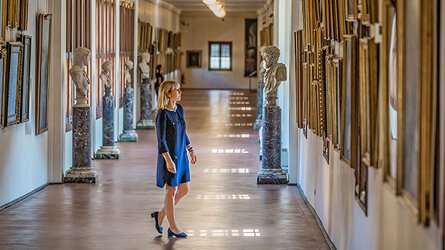
Viking are destination experts. With no casinos or children on board, you can be assured that the focus is firmly on enrichment and education. Read more
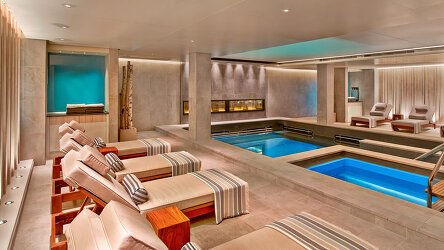
After a day of exploration or just to enhance the relaxation of a day at sea, the on-board Spa will leave you feeling recharged and revitalized. Read more

Viking offer eight on board dining options. Beer, wine and soft drinks are available with lunch and dinner at no additional charge of fee. Read more

Viking proudly includes all that you need and nothing you do not. A variety of features and services valued at $200 per person per day are standard inclusions in your cruise. Read more

Viking include one complimentary shore excursion in every port of call. Enjoy exclusive entry to cultural treasures and seldom-seen collections around the world. Read more

Viking Venus Reviews (4) Most Recent 'Viking Venus' Reviews
The service on board was excellent and all of the staff from the Captain, General Manager, Customer Relation Staff, Bar and Service staff as well all the entertainers were fantastic and made our journey one to remember. I would rather have been delayed in Tromso on board the Viking ship than up a mountain in a hut with no heating, food or drink and the bonus was we got to see the Northern Lights. Thank you Viking for a wonderful trip and the very generous discount on future cruises and I look forward to my river cruise next year. Well done everyone.
Brochure

Viking World Cruises (2024-25)
Availability Click on prices below to view cabin upgrades and details
Tour & cruises prices are per person. Prices shown have savings applied, are subject to availability and may be withdrawn at any time without notice. Prices and trip information are correct at the time at this point in time, however are subject to confirmation at the time of booking and are subject to change by Viking. For cruise itineraries, cabin images are sourced from Viking. These should be treated as indicative only. Cabin inclusions, upholsteries and room layout may differ to the image(s) shown depending on the ship selected and your sailing dates.
